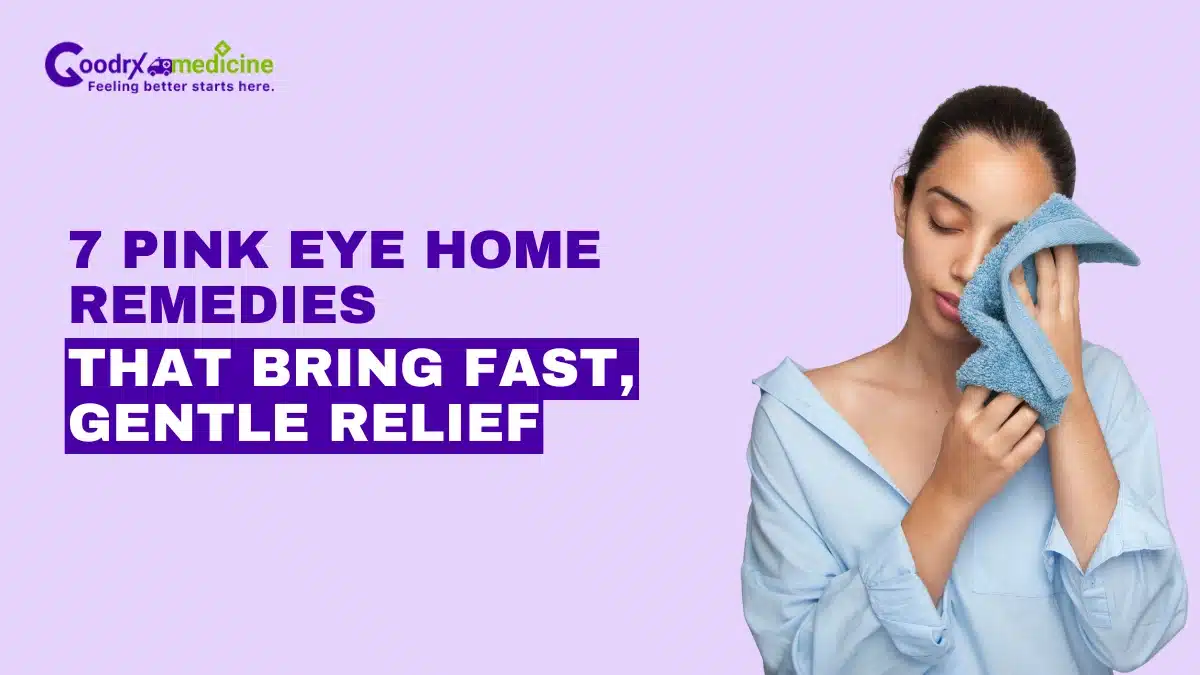Pink Eye, also known as Conjunctivitis, is a common eye issue that causes redness, itching, and irritation. Millions of people in the United States experience it yearly, making it one of the most frequent eye concerns.
The good news is that in many cases, you can ease the discomfort with simple steps at home. Many individuals prefer trying safe and natural solutions before seeking other options.
Home remedies are gentle, affordable, and easy to find in your daily surroundings. This article will walk through trusted Pink Eye home remedies that offer comfort and relief. Keep reading to learn more.
7 Safe and simple Pink Eye Home remedies
Pink Eye (Conjunctivitis) is the irritation or inflammation of the Conjunctiva (a transparent and thin membrane covering the eye’s white part and inner eyelids) that may cause eye redness, watery discharge, and more. Taking proper care of your eyes is essential when you have Pink Eye.
Some simple and effective home remedies may help relieve Pink Eye symptoms. They can help you feel better and keep your eyes clean while the condition improves. The main goals of at-home care for Pink Eye are:
- Easing discomfort or itching.
- Keeping your eye area clean and free from discharge.
- Stopping the spread to others or your other eye.
Home care helps, but don’t delay medical attention for severe symptoms.
The home remedies include warm compress, cold compress, using eye drops, and avoiding contact lenses. These steps do not replace professional advice but can give you comfort. Let us discuss the Pink Eye home remedies in detail.
- Warm compress
A warm compress is one of the simplest and most effective home remedies for Pink Eye, especially when dealing with Viral or Bacterial types of Pink Eye. It offers soothing relief by reducing swelling and easing discomfort around the eyes. A warm compress can also help loosen any sticky discharge or crust that may form on the eyelids, making it easier to clean your eyes gently.
To make a warm compress:
- Boil some water and let it cool until it feels comfortably warm.
- Soak a clean, soft cloth in the warm water.
- Wring out the extra water so it is damp, not dripping.
Place the compress on your closed eyelids for about 5-10 minutes. Repeat this process several times daily, using a fresh cloth each time to keep the area clean. This simple practice can significantly ease irritation and support your eyes as they heal naturally.
- Cold compress
A cold compress is a gentle and effective home remedy specifically suited for Allergic Pink Eye. This type of Pink Eye can be painful, with inflammation and itching, making your eyes uncomfortable. A cold compress helps reduce swelling and numbs the irritated area, providing soothing relief from the discomfort.
To prepare a cold compress, you will need to:
- Soak a clean, soft piece of cloth in cold water.
- Wring out the excess water so the cloth is damp but not dripping.
- Optionally, you can chill the cloth in the refrigerator for an extra cooling effect.
Close your eyes and gently place the cold compress over your eyelids for 5 to 10 minutes. You can repeat this process several times a day as needed. The cold compress calms the inflammation and helps reduce redness, making your eyes feel more comfortable and refreshed during allergy flare-ups.
- Use eye drops
Artificial tear drops, also called lubricating eye drops, may help provide gentle relief from Allergic Pink Eye by keeping your eyes moist and washing away allergens like pollen or dust that irritate.
Many people find that using these Pink Eye medicine eye drops several times a day makes their eyes feel more comfortable. The drops can also ease common symptoms such as:
- Burning
- Dryness
- Redness
You may find relief by using preservative-free artificial tears for frequent comfort.
- Avoid contact lenses
Avoiding contact lenses is one of the most critical steps when you have Pink Eye. Contact lenses can trap dirt, bacteria, or allergens close to your eye and worsen the irritation.
They can also spread the infection from one eye to the other or other people if not handled properly. For this reason, you should switch to glasses until your eyes heal fully.
During this time, it helps if you:
- Stop using contact lenses right away
- Throw away old lenses and solution
- Replace your lens case with a new one
- Buy a fresh pair of contact lenses before using them again
Taking these steps reduces the risk of reinfection and helps your eyes recover more comfortably.
- Saline solution rinse
Saline solution is a saltwater rinse that helps wash out irritants and keep eyes fresh. It can also be used for contact lenses, and you can buy sterile saline solution at a pharmacy.
Do not try to make saline at home, as homemade mixtures are not sterile and may cause infection. Instead, gently rinse your eyes using clean saline solution to remove common irritants such as:
- Dust
- Pollen
- Dried discharge
This simple method is especially effective if allergies or irritants trigger your Pink Eye. It keeps your eyes cleaner and more comfortable.
- Over-the-counter pain relievers
Over-the-counter (OTC) pain relief medicines, such as Acetaminophen or Ibuprofen, can ease mild pain or reduce swelling caused by Pink Eye. These pain medications do not treat the infection, but can help you feel more comfortable while your eyes heal naturally.
It is essential to follow the instructions on the package or those given by your doctor to avoid any side effects or complications. Before taking any over-the-counter Pink Eye medicines, consider factors such as allergies, other health conditions, or your current medications. Key points to keep in mind include:
- Use the correct dose and timing as directed.
- Avoid combining multiple pain relievers without professional advice.
- Stop use and seek help if you experience unusual side effects.
- Keep medication out of reach of children.
When used responsibly, OTC pain relievers are reliable for temporary symptom relief during Pink Eye treatment and recovery.
- Allergy management
If Pink Eye is caused by allergies, managing those allergies at home can significantly reduce symptoms and flare-ups. Limiting exposure to common allergens such as pollen, dust, or pet hair can help keep your eyes calmer and less irritated. Simple steps to reduce allergen contact include:
- Keeping windows closed during high pollen seasons.
- Using air purifiers to clean indoor air.
- Regularly dusting and vacuuming your home.
- Avoid outdoor activities when pollen counts are high.
In addition, allergy-specific eye drops and oral antihistamines can provide relief by controlling redness, itching, and swelling. These over-the-counter (OTC) medications are generally safe when used as directed and offer effective comfort for allergy-related Pink Eye. Studies support the use of these treatments as helpful home care solutions for Allergic Conjunctivitis when used correctly.
Save up to 90% on your medicine bills

Eyemist Forte 10 ml

Restasis 0.05% Ophthalmic Emulsion 0.4ml

Milflox 0.5% 5 ml

Pred Forte 10 ml
Home remedies to avoid
While the internet and word-of-mouth suggest many home remedies, not all are safe. Some can make your symptoms worse or even cause harm. Using unsafe remedies increases the chance of irritation, allergic reactions, or the spread of infection.
Avoid these common yet risky Pink Eye ‘home remedies’:
- Do not use breast milk, urine, or bodily fluid in the eye. There is no reliable evidence supporting their safety or effectiveness for Pink Eye. These can introduce germs and make things worse.
- Do not use ‘red eye’ drops that are not labeled for lubricating purposes. These can cause more redness or burning.
- Do not use any home remedy if you feel severe pain, have vision changes, or if symptoms get worse.
Healthcare experts strongly caution against using unapproved or untested home remedies. Only use what studies or your eye care professional support.
Conclusion
Pink Eye can feel uncomfortable, but safe at-home care can make recovery smoother. Simple steps like using a warm compress for soothing relief, applying a cold compress for allergy-related irritation, or rinsing with saline solution help keep your eyes clean and calm.
Artificial tears can ease dryness and burning, while avoiding contact lenses prevents further irritation and reinfection. Over-the-counter pain relievers may also reduce discomfort, and managing allergens such as pollen or dust can stop flare-ups.
However, it is equally vital to avoid unsafe practices like using breast milk, urine, or untested herbal drops in your eyes. With proper care, most cases improve naturally within days.
Still, if symptoms worsen, persist, or affect your vision, seek professional help without delay. Practicing safe and simple Pink Eye home remedies supports comfort and healing. Still, medical attention remains essential for severe or stubborn cases.

Frequently Asked Questions
How to treat Pink Eye while pregnant?
To treat Pink Eye during pregnancy, use cool compresses and clean your eye with a wet cotton. Stop wearing contact lenses and use artificial tears. If symptoms persist, consult a doctor for a safe antibiotic ointment or antihistamines. Maintain proper hygiene and avoid touching your eyes with dirty hands.
How long does Pink Eye last?
Pink Eye typically lasts one to two weeks. Viral pink eye clears in 7 to 14 days, while bacterial Pink Eye improves within 1 to 2 weeks, especially with antibiotics. Allergic Pink Eye lingers while exposed to allergens. Contagiousness lasts for the duration of symptoms, improving in 3 to 7 days.
How to tell if Pink Eye is bacterial or viral?
You can distinguish between Viral and Bacterial Pink Eye by the discharge and symptoms. Watery discharge that spreads suggests a viral infection, while thick pus indicates a bacterial infection. Viral Pink Eye often accompanies a cold, whereas Bacterial Pink Eye causes more pain and swelling. Consult a doctor if unsure.
What is commonly misdiagnosed as Pink Eye?
Common conditions mistaken for Pink Eye include allergies, Dry Eye, eye strain, Blepharitis, and contact lens irritation. Styes and corneal inflammation can also be confused with Pink Eye. Seeing an eye doctor can help find the right cause and treatment for your eyes.
What antibiotic eye drops are safe for children?
For children, some antibiotic eye drops that are safe include those with ingredients like Polysporin and Trimethoprim, Moxifloxacin, and Gentamicin. Eye ointments with Erythromycin or Ciprofloxacin are also safe. Always use eye drops prescribed by a doctor to keep the eyes healthy and safe.
When referencing outside resources, GoodrxMedicine always provides full citations. To learn more about the measures we use to maintain the quality of our content, please review our Content Information Policy.











